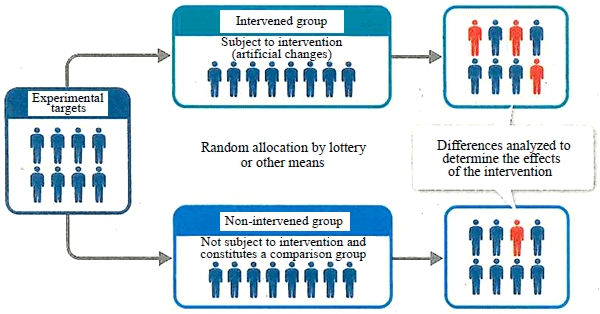Behavioral economics is a field of study that attempts to explain irrational human behavior scientifically. What is important in this approach is to make an accurate analysis of actual human behavior, for instance, as to how people behave and what factors cause behavioral changes. In recent years, it has become possible to conduct experiments in economics to obtain a precise understanding of human behavior.
It has long been believed that experiments are difficult to conduct in economics. However, recent years have seen a series of economics experiments conducted in the field, i.e., real-world economic environments, by using a randomized controlled trial (RCT).
RCTs are a form of experimental method that divides experimental targets—individuals, households, businesses, or else—into multiple groups and compares the effects of certain intervention across different groups. The point is to divide targets randomly into groups. This is meant to create a situation where the groups are no different except for whether or not being subject to the intervention, and thereby to remove bias from experimental results and identify causal relationships (Figure).

In campaigning for the U.S. presidential election in 2008, Barack Obama's camp selected its website design by using an RCT. It prepared 24 website designs using different images and wordings on click buttons, displayed them randomly to 310,000 viewers, and measured the percentage of viewers who registered their name address for each. The one that had the highest registration rate was used in the campaign.
The design selected by viewers was not the one the camp had expected. This means that Obama's campaign staff were able to build a smarter strategy than relying on their intuition.
Sales affected by whether stated prices are tax inclusive or exclusive
How do economists utilize RCTs? One good example is a 2009 study conducted by Stanford University Professor Raj Chetty, which showed how consumers change their purchasing behavior depending on whether retail prices shown on the shelf of grocery stores include or exclude sales taxes.
First, he divided grocery stores randomly into two groups, those subject to intervention and those not. Then, he put tax-inclusive prices on some randomly selected items sold in stores belonging to the intervened group. In the United States, retail prices are, as a rule, exclusive of sales taxes. Thus, in this experiment, all items except for those selected for intervention were carrying pre-tax prices.
As a result of this experiment, it was found that there exists a clear causal relationship, in which sales of items tagged with tax-inclusive prices decrease by an average of 8% compared to those tagged with tax-exclusive prices. The traditional economic theory assumes that whether prices are tax inclusive or exclusive would not affect consumers' purchasing behavior provided that they can calculate tax amounts, because either way they would be paying the same amount at the register. Findings from the experiment point to the possibility that this long-standing assumption may not hold true. They also provide significant implications to public economics, another area of economic study that examines tax systems and public policies, needless to say that they also contribute to retailers' business strategies.
Field experiments utilizing RCTs are now being introduced in many other areas of economics, including those concerned with the environment, medicine, the development of developing economies, and energy. With the advent of RCTs, economics of the 21st century will likely evolve into a new stage.
* Translated by RIETI.
November 25, 2017 Weekly Toyo Keizai


